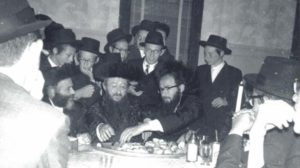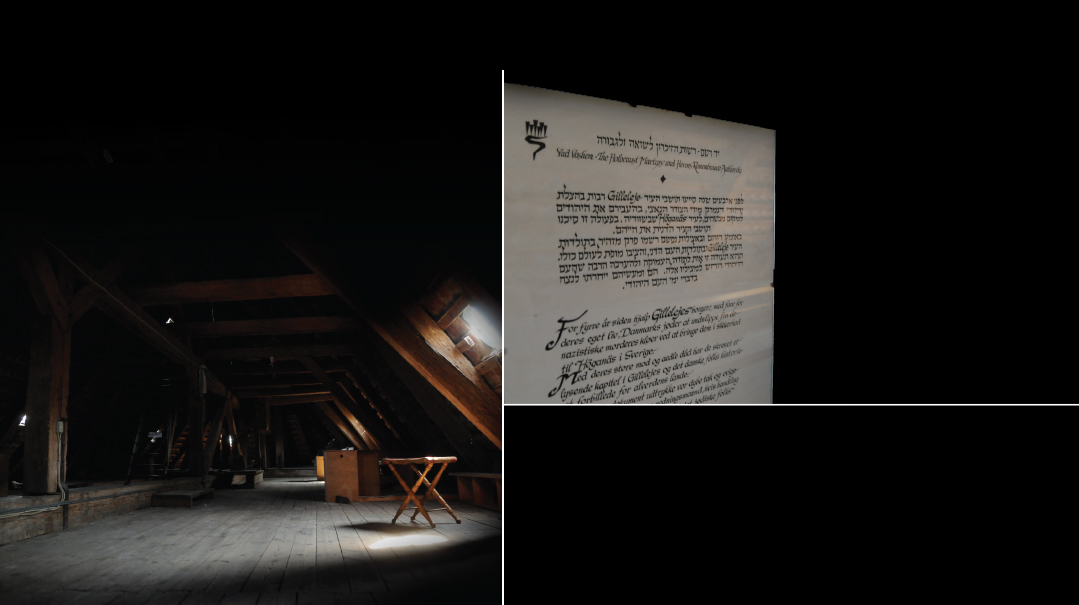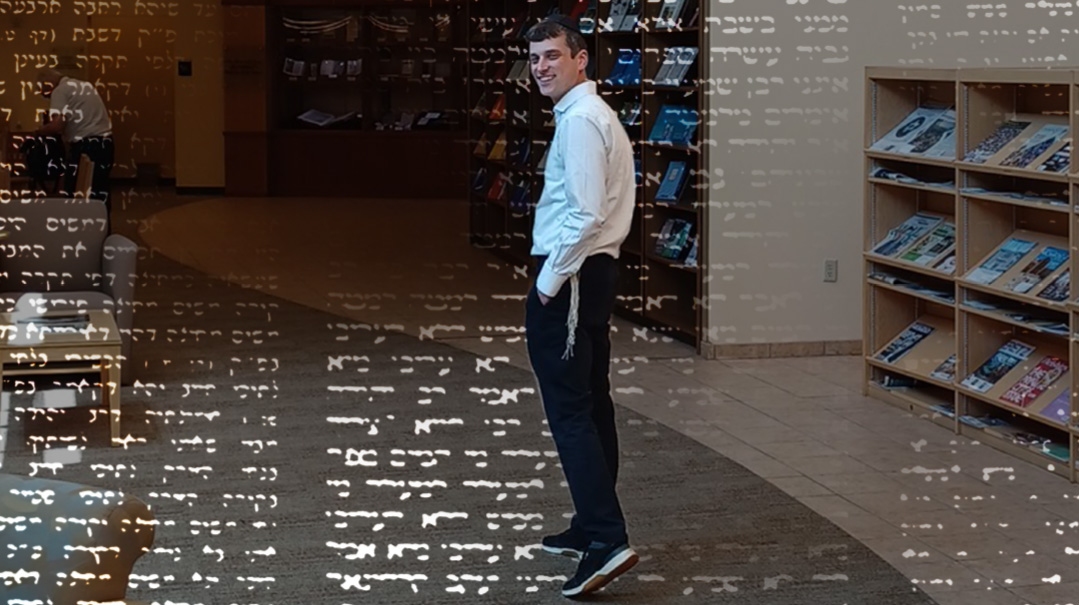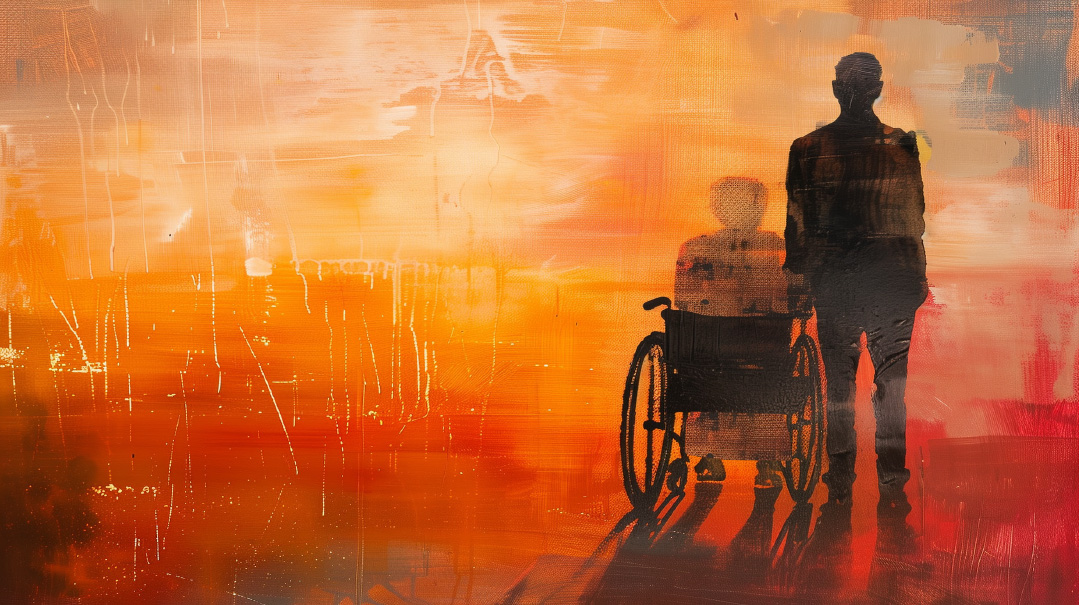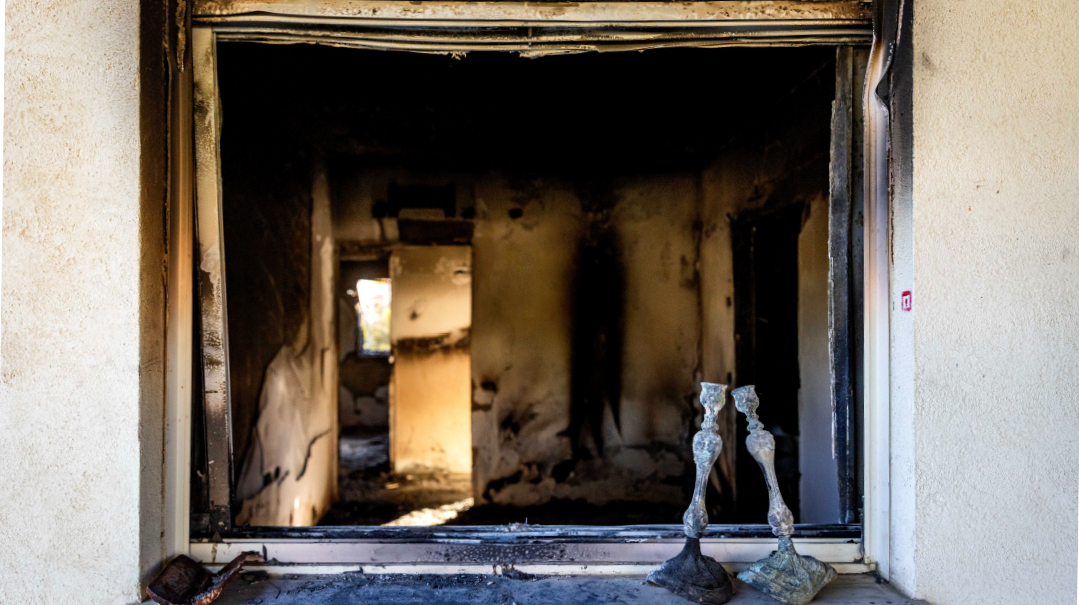Never ever alone
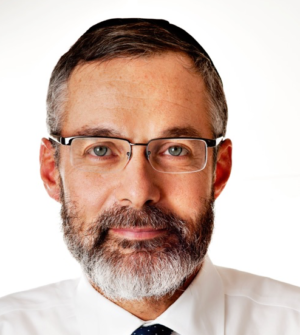
An incredible saga. A medical miracle. A true account in 8 chapters
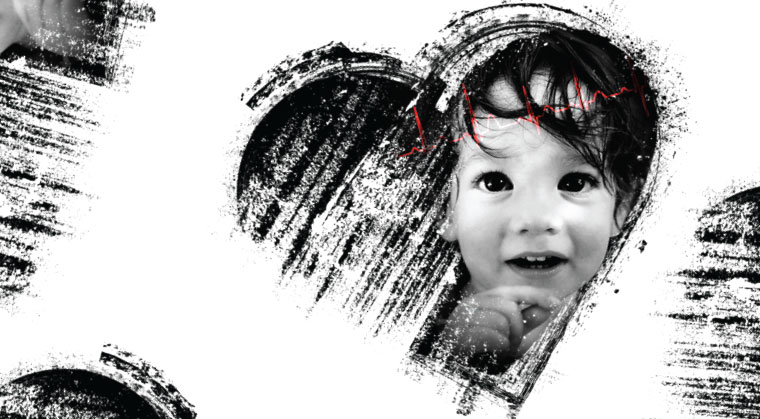
Chapter 1 Pre-Bris Jitters
“Something’s wrong with the baby.” It was just a few days after my son’s birth in Jerusalem at the very end of 1992. The bris planning was well underway — hall caterer photographer and sandek… my rebbi.
But my wife Chana insisted that we couldn’t do the bris. She had a feeling that the baby wasn’t well. We went through a checklist: pulse normal nursing okay muscle tone good pupil dilation. (My wife had long taken an interest in informal medical study.)
“So what makes you think there’s something wrong?” I asked.
“I just have this feeling ” she answered.
“Should we go check the baby out in the ER? They’ll catch whatever it is.”
“No ” she said. “But we can’t do the bris.”
Beginning to feel a certain anxiety myself I called my sister’s husband Jules Gardin a very famous cardiologist in New York. I told him really nothing was wrong with the baby but Chana was having pre-bris jitters. He asked to speak to her. I could hear only her half of the conversation which basically amounted to her insistence that something was wrong.
Jules then told me “Listen you cannot give a bris milah to a child whose mother is panicked. It’s not nice! You gotta calm her down.”
He advised me to call a friend of his Dr. Dan Tzivoni the head of cardiology at Shaare Zedek. He would check the baby and give the thumbs-up to proceed with the bris.
We bundled up the baby and shot over to the hospital in a cab making our way to the cardiac unit on the fifth floor. The secretary there stubbornly refused to let us see Dr. Tzivoni and offered an appointment in 90 days. When I mentioned Jules’s name the recalcitrance in her eyes thawed by one degree; she went into the back of the office and two minutes later a man in a white coat came out.
“What are you doing here?” he asked.
“It’s my baby ” I said gesturing behind me to Chana who was clutching the child.
He took one look at Chana’s face and called out “Orderly! Give that baby an echocardiogram!”
Another guy in a white coat nearby grabbed the baby like a football and took off down the hall. Dan Tzivoni went running back to his office. We went in pursuit of our child.
We got to the door of a room filled with physicians. Our baby was on the table being poked and prodded with jelly on his belly and his heartbeat displayed on a big screen: tha-thump tha-thump. Chana and I stood in the hall watching.
“How are we going to get a well baby checkup?” Chana wondered.
“Don’t worry ” I reassured her “when they’re done in there they have to show that test to Dan Tzivoni and we’ll explain that it was a mistake we just wanted a well baby checkup and he’ll tell us what’s going on.”
After 45 minutes they finally flipped off the machine all but one of the doctors filed out and he invited us in to sit down. He rolled his chair over and closed the door.
“Mr. and Mrs. Kelemen your baby should be dead ” he informed us.
“He has dozens of holes in his heart, and he has a blocked aorta. The only reason he’s alive is because of a fluke — the ductus arteriosus, an artery that is normally only open in utero and closes after delivery with the baby’s first breath, didn’t close for him.”
The doctor, a pediatric cardiologist, explained that while the ductus arteriosus was open, the baby was able to have something approximating normal circulation. But this artery was designed to close upon exposure to oxygen.
“Eventually it’s going to close,” the pediatric cardiologist said, “and then your baby is going to die.”
I asked about surgery, but the doctor explained that no surgeon in Israel would touch this case because the outcome was a foregone conclusion: “These kids never make it.”
When I insisted that we would do whatever necessary to save our son’s life, the pediatric cardiologist relented a bit and said there were three doctors in the world who might be willing to perform an experimental procedure — one in Boston, one in New York, and the best one, Dr. Hillel Laks, in my hometown of Los Angeles.
In the meantime, however, we faced a roadblock that was all but insurmountable: Our infant son, in order to survive even the next few minutes, would need to be placed in a special incubator that strictly regulated his oxygen intake, to prevent triggering the closure of his ductus arteriosus. This incubator was not transportable. When I asked if it came in a mobile version, the doctor said yes — but not in Israel.
Even if we were somehow able to obtain this mobile incubator from another country, he said, we would face a new obstacle: the passenger cabin of a jetliner is pressurized with a very high-density oxygen atmosphere. Were our son to get one whiff of that air, it would kill him. To keep him alive, his incubator would have to be sealed, airtight, and receive a special feed from a dedicated low-density oxygen tank.
To complicate matters even further, the Federal Aviation Administration had enacted a rule forbidding planes from entering US airspace with such customized oxygen tanks on board. A couple of years before, a plane had lost air pressure in the cabin, and a passenger’s oxygen tank exploded.
“Therefore, Mr. Kelemen,” the doctor concluded grimly, “you are not going anyplace.”
A cold reality began to sink in. I asked what we should do now.
He said we could accompany the staff to put our son in the hospital’s special incubator in the pediatric ICU. I held my little boy’s head for over an hour, while they inserted tubes in through his head, one by one. Then they took him and settled his tiny form down in the incubator, sealed it, and that was it. At the top of the incubator was a little window, through which we could see a shadow of a child.
The head of the pediatric ICU approached us and suggested it might be a good time to call a rabbi. I had never been through the death of someone this close to me before, and I had no idea how I was going to react. He handed me a slip with a name and phone number and said, “Call this rabbi.”
It was 12:30 at night. Chana and I walked out into a hallway and found a phone. I then saw that this number was for a rabbi in Bnei Brak. I figured he must be an expert at counseling people facing very serious situations like this. Amazingly, a secretary answered the phone, and put me on with this rabbi.
“Hello, this is Rabbi Firer. How can I help you?”
I explained we were calling from Shaare Zedek in Jerusalem, where the doctors had just informed us that our newborn son’s heart was full of holes, and his aorta was blocked.
“Hmm… multiple VSDs and a coarc.”
After a pause, he pronounced that our baby needed emergency surgery, but no surgeon in Israel would do it — possibly a doctor in Boston, or in New York, but our best hope lay with Dr. Hillel Laks in Los Angeles. Before I could register amazement at his expertise, he went on to list all the complications involved with flying our little patient to California — starting with the lack of a mobile incubator in Israel.
“There is a mobile incubator in France,” Rabbi Firer said. “I think I can get it to Jerusalem by tomorrow night. You’ll be able to fly out then.”
He advised that he did not have a solution for the oxygen, but in the meantime he would work on the incubator. Then I heard the dial tone.
I put down the phone, and Chana asked, “What happened?”
All I could say was, “I don’t know!”
Chapter 2 Every Minute Is Crucial
When I explained Rabbi Firer’s plan to the head of the pediatric ICU, he shook his head. “This is going to cost you tens of thousands of dollars, and these kids never live. Don’t do this, Mr. Kelemen.”
But my wife and I looked at each other and saw the conviction mirrored in our eyes.
The doctor capitulated, but then brought up an important point: Given the amount of equipment we’d have to fly with, we’d probably need the whole back row of seats in a 747. If we were to fly out the next night, we’d need to check ticket availability immediately.
It was one in the morning when I phoned my travel agent, Sossi Abramowitz (a.k.a. “the Angel”). The urgency in my voice brought her out of her sleep. I detailed the entire situation for her, from my newborn son’s diagnosis up through Rabbi Firer’s plan — to the part where Sossi could help. I explained the problems with the oxygen, and the back row of the 747. She told me to stand by and wait for her call.
About 45 minutes later Sossi reported, “Leib, I got you back rows on two 747s.”
She recounted her negotiation with El Al, who offered to fly us on a 747 leaving Tel Aviv at 1 a.m. for New York; we’d have to find our own connection to Los Angeles. “However, when you land in New York, someone is going to see the oxygen tank, and you’re going to be in trouble.” El Al declared they would assume no responsibility for that: We could bring the tank on board, but the airline would tell the FAA we smuggled it on without their knowledge, and we, not the airline, would have to pay the resulting $50,000 fine.
I had been learning in kollel for about ten years, so my heavenly bank account was better endowed than my earthly one. I nevertheless assented to El Al’s offer.
But there was another dilemma to contend with. Sossi the Angel explained that if we took the El Al flight — which fit best with Rabbi Firer’s plan — we’d be not just fined, but arrested in New York, and our child would never make it to the surgery in Los Angeles. Besides, which domestic US airline would consent to bring the oxygen tank for the final leg of the trip?
So Sossi had found us a second option: a direct Tel Aviv–Los Angeles flight on Swissair, leaving 12 hours later than the El Al flight. (This was the other 747.) This would take us straight to our destination, and although we’d be arrested, at least our baby would arrive in L.A. and have a chance at his lifesaving operation. The hitch, of course, was the departure time 12 hours later — when every minute was crucial.
When Sossi asked which one to book, I couldn’t decide, and asked that she hold both reservations for us. She agreed.
We went back to the pediatric ICU head to present our options, but he introduced a new wrinkle: Shaare Zedek would not release the baby unless we found a qualified cardiologist willing to accompany us on the flight to handle any emergency that might arise. They offered to help us find someone. We agreed, thanked them, and bade them good night.
Chapter 3 The Tiniest Diplomat
When we got home at 2:30, Chana collapsed with exhaustion. I couldn’t sleep a wink. So when the phone rang at three, I sprang to take the call. I heard a woman barking a series of instructions.
She turned out to be the chief administrator at the Ministry of the Interior. In all the commotion, it hadn’t occurred to me that our baby would need a passport. She offered to personally prepare one for us, but we had to appear at her office at 7:30 a.m., one hour before opening time. She listed all the documents we needed to bring, but admonished us to be on time because she had to leave promptly at 8:30 for a meeting in Tel Aviv.
Before she hung up, I managed to ask how she had found out about our situation. She responded as if it were the most obvious thing in the world: “Senator Moynihan told me.”
I just thanked her profusely and promised to show up at 7:30.
I caught a cat-nap after that, but got up with Chana at 5:30 to race over in a taxi to Shaare Zedek. As we entered the pediatric ICU, we were intercepted by the department head who had helped us the night before.
“Mr. Kelemen, you’re a very lucky man.” He recounted that after we had left, they replayed the echocardiogram, and saw that with every beat of our child’s heart, his ductus arteriosus had been closing. They’d started him on prostaglandin IVs, which froze the ductus arteriosus in a half-open position. The baby was at that moment in critical condition, but stable.
We sat there with our baby in his big box until 7:10 a.m., when we had to leave to get the passport. When we arrived at the Misrad Hapnim, the doors were chained closed, but the guard posted out front asked if we were the Kelemens.
“She’s waiting for you, third floor, first door to the left,” he said.
We found her sitting at her desk, puffing away on a cigarette.
“Quickly, come in, come in, we’ve got no time!” she said. She took our papers and gave us forms to fill out, working frantically until suddenly at 7:50 she said, “Give me the birth certificate from the hospital!”
I riffled through the entire file once, then searched again page by page, as this woman got more and more nervous.
“Give me the certificate of live birth! We have to get on with this!”
My eyes were blurring after only two and a half hours of sleep, so I handed the file over to Chana. She went through the file twice and whispered to me, “Leib, it’s not here!”
I took the file and just dumped everything out onto her desk. As we sifted through everything once again, my mind was racing — What did I do with it? I put my head down. Then it hit me. I announced, “It’s in my kid’s file in Shaare Zedek, call them, they’ve got it.”
The woman leaned back in her chair and said, “I’m sorry, Mr. Kelemen, I can’t help you.”
I said, “What are you talking about? Call them up and they’ll tell you they’ve got the certificate of live birth! They can fax it to you!”
“Mr. Kelemen, I have to see the original,” she insisted. “I told you to bring all the papers. I have to see it, I’m sorry.”
I leaned over and said, “Do you understand that if you fail to issue this passport, you’re killing my kid?”
She looked straight back at me and replied, matter-of-factly, “Mr. Kelemen, I told you to bring all your papers.”
It was absolutely useless talking to her. The clock read eight minutes to eight; she would be leaving at 8:30.
I said, “Chana, let’s go.”
The woman emphasized once again that she was leaving at 8:30, and I assured her we’d be back in time.
We bolted out the door. Chana, who had just had a C-section, said, “There’s no time for the elevator!” and started running down the stairs. When we got to the bottom, she cried, “If there isn’t a taxi outside, we’re finished!”
Just then, a taxi pulled up to let out a passenger. Chana and I jumped in. I said to the driver, “Quick! Shaare Zedek!”
The guy looked over his shoulder and saw my wife. He jammed down the gas and used both sides of the road all the way to Shaare Zedek, screeching to a halt in front of the emergency entrance.
I hopped out and told Chana to stay in the cab. As I ran through the door, the driver got out of the taxi and screamed after me, “No! Your wife! Your wife!”
I raced up five flights of stairs and through the halls to the PICU front desk, grabbed the first doctor I saw and said, “Quick! I’ve gotta have my baby’s birth certificate!”
This guy put his arm around me and said, “Shhh… Come with me.”
And he escorted me to just outside the entrance to the ward, and said, “Mr. Kelemen, do you see these doctors over here?” He indicated a crowd of men. “These doctors are visiting from abroad. They should be done in about an hour, and we’ll be with you then.”
He entered the ward, closed the door, and locked it.
That was it. I couldn’t get the birth certificate, so I couldn’t get the passport, so I couldn’t fly my kid out that night, which meant no surgery. As tears streamed down my face, I just kept saying, “Hashem, please, save my son. G-d, please save my son!”
An old Yerushalmi lady mopping the hallway saw me crying and walked over and said, “Don’t worry, it’ll be okay.”
This was the wrong thing to say. “It’s not going to be okay!” I said. “I need to get birth certificate… baby… flying.. America… surgery!”
She listened to the whole story and said, “Zeh nora! This is terrible!” And she threw down her mop and took off running down the hall, to a young lady at the information desk. This old Yerushalmi lady repeated everything to the young lady, who hopped up and ran to a bank of file cabinets, rifling through the drawers. She grabbed a paper, ran and handed it to the old Yerushalmi lady, who turned to run back toward me. I barreled down the hall and grabbed the paper from the Yerushalmi woman, who called after me, “Mazel tov!” as I headed down the five flights of stairs.
As I flew out of the emergency entrance toward the taxi, I saw the driver was trying to coax my wife out through the open car door, saying, “Baby! Hospital!”
I hopped in the cab. The driver shot me a look. “Quick, to the Misrad Hapnim!” I said.
“Atah meshuga?”
But he got behind the wheel and peeled off, again driving on both sides of the road all the way back to the Department of the Interior. He came to another screeching halt in front of the building. I’ll never forget his face: This man was white. He turned around and said, “Don’t pay, just get out!”
Chana and I clambered out and ran in. Again no time for elevators — we charged up three flights of stairs. We were running toward this woman’s door when it opened, and she walked out with her purse.
I looked at my watch —it was 8:28 — and I said, “I got the birth certificate.”
She replied, “Mr. Kelemen, I told you I have to leave at 8:30. I’m sorry, but I can’t finish it up in two minutes, I’m very sorry.”
She started to leave and I blocked her way. “Please,” I said, “if you leave, my baby is going to die. Please.”
“Okay, quickly, get your papers.”
We ran and gathered up all the papers off her desk, and she took us down to her secretary, who finished filling everything out and gave us the form that would allow us to get our baby’s American passport.
Our next stop was the US consulate, and after a long wait we were admitted to the passport section. There at the counter behind the window sat Mohammed. I said to him, “Listen, my baby has a medical emergency —I’m an American citizen, my wife is an American citizen, and we’ve got to get a passport for this kid now!”
“It’s not a problem, Mr. Kelemen,” Mohammed replied calmly. He had us fill out a form, go pay at a different window, and come back to him with the receipt.
“Mr. Kelemen, you’re all set,” he said. “Give me picture, have seat, and in 15 minutes, I give you passport.”
“I don’t have a picture, because the baby’s in a big box,” I said.
“Oh, Mr. Kelemen — no picture, no passport.”
I began rehashing the same argument I had with the Misrad Hapnim lady, but Mohammed took out a big book the size of the New York telephone directory. He thumbed to a certain page, pointed at a regulation in tiny print, and said, “Mr. Kelemen, it says right here — no picture, no passport. I’m very sorry.”
This went on until I remembered something I learned in fourth-grade social studies class. They taught us about a law I thought was so cool, I never forgot it: An American citizen in a foreign country at a US consulate can demand that the consul-general come to him. I took out my passport, put it up against the glass and demanded to see the consul-general immediately.
I brushed off Mohammed’s excuse that the consul-general was in Tel Aviv, asserting that I knew my rights under the law. Here he got very frustrated, but I was adamant. Realizing he had no choice, he got up from his seat, wandered to the back of the office, and began talking into a radio handset. After a moment he came back and dutifully reported that the consul-general was coincidentally already on his way and would arrive in 15 minutes.
So we sat down and waited. Right on time, a tall clean-shaven man, hair combed to the side, entered the office on Mohammed’s side of the glass and beckoned to me to approach. As I got to the window, I saw the same big book open in front of him.
“Mr. Kelemen, as Mohammed was telling you, we cannot assist you because we cannot issue a passport unless we have a picture,” said the consul-general. “We would like to help you out but we’re just bound by American law. We’re very sorry.”
I went through the whole story one more time. It was like trying to reason with an ice cube. Finally I blurted out in exasperation, “I cannot believe that I’m an American citizen and my wife is an American citizen and all we want to do is fly our kid out of this country and you won’t let us.”
He stopped me and said, “You didn’t say you wanted to fly your kid out of this country. You said you wanted a passport.”
“What are you talking about?” I was dumbstruck.
“Just a minute,” he said, flipping through the book. Finally he came to the page he wanted. “There’s a law here that says that we can write the Israelis a letter telling them your child is a visiting American diplomat. That will get your kid out of this country. The next law says we can write the US government a letter saying your child is a visiting Israeli diplomat. That will get him into America.”
My head was spinning. “We’ll take two, please, yes?”
On the spot the consul-general himself drafted the letters, signed them and gave them to us, and we hurried back to Shaare Zedek.
Chapter 4 A Bad Feeling
When we entered the hospital, I had a bad feeling, but I just couldn’t bear to tell Chana. In the meantime I still hadn’t davened Shacharis. I put on my tallis and tefillin and I stepped up to a wall at Shaare Zedek. It remains the most unusual tefillah in my life. “Hashem, please save my kid,” I kept repeating. It was the first time in my life that I felt I had absolute and total clarity.
I felt completely forsaken, totally alone — like there was no one listening. It was a palpable feeling of complete abandonment. I’ve never had the experience before or since. I just stood there with my eyes closed and the tears pouring down my face, crying, “Please, G-d, not now, please, please, don’t leave me now, please!”
It felt like talking on a dead phone line. After a half hour I stepped out of Shemoneh Esreh, walked back, took off my tallis and tefillin. I just knew that something bad had happened. I walked over to Chana, sitting in the lobby. She had melted into the chair and she was sobbing.
“I know what’s going on upstairs,” she said.
I sat down next to her. “I know too,” I said. “I think we should go upstairs.”
It took us a moment to get our courage together to go up to the pediatric ICU. When we got there, we saw all the doctors crowded in a circle. There was some emergency situation underway, and our feelings of cold dread seemed to be confirmed.
We stepped forward. One of the doctors glanced over and saw us, and waved us in. People parted in front of us and in the center sat the assistant head of pediatric ICU, with a telephone on her lap.
She was hunched over, saying, “You’ve got it? The oxygen’s a go? Okay, fine, okay.”
She hung up, looked up and saw my face, and it was as if she’d just seen the Red Sea split. “That was the FAA representative responsible for oxygen,” she said.
She explained in a rush that we had gotten clearance to bring an oxygen tank on a plane into US airspace. No arrests, no $50,000 fines. We would be leaving at 1 a.m. that night on a flight to New York, with a connection to Los Angeles. It was all a go — with one small hitch.
“You better call the airline and make sure that the equipment you’re flying with is compatible with the electrical system on the plane,” she cautioned. She gave me an El Al number that the hospital had obtained.
Our next call was to Rabbi Firer. He said the incubator was on the way from France and would arrive in time for our flight — they’d bring it from Ben-Gurion, over to Bnei Brak, then straight to Shaare Zedek. In the back of my head I was wondering why a side trip to Bnei Brak was necessary. But I just asked him what voltage the incubator ran on. He told me 250 volts.
With that information I contacted the chief engineer at El Al. I said I was the father of the baby flying that night, and he asked right away what was the voltage of the incubator. He was not happy to hear that it was 250 volts. I asked what we could do.
“We flew that incubator once before,” he said. “We had to build a whole conversion board to allow the unit to work on our plane. Let me call you back.”
Half an hour later he reported that he took a stroll down to the hangar and found the very conversion board they used the first time, leaning up against a wall. We were all set, he told us — but he warned us to call TWA Airlines, to make sure everything would work on the connecting flight to Los Angeles.
We managed to reach the TWA chief engineer. His news was not encouraging: his planes’ electrical systems were incompatible both with 250 volts and with El Al’s power configuration — so the conversion board wouldn’t work. But he advised me not to despair. We would be arriving in New York in 14 hours; he told us to ask El Al to fax him the blueprints for the conversion board, and he would task his engineering team with rigging something up to work on the TWA plane. El Al sent the documents over to him in no time. (Keep in mind, this was 1992 — e-mail, PDFs, and Internet were not in general use. Fax machines were state-of-the-art.)
Chapter 5 Mission Control
We’d planned for my wife to bring the baby to Los Angeles while I’d stay with our other children. That night at 11:30 the two of us stood outside the pediatric ICU giving each other encouragement.
The utility elevator doors opened suddenly and our heads turned toward the sound of something big rolling in and men running. Into the light of the pediatric ICU burst four chassidic men in big black hats, long coats and peyos flying behind them, pushing a gurney with an immense glass-encased machine strapped to the top. Their leader, the rabbi, called out, “Where’s Kelemen?”
I stepped forward. “Where’s the cardiologist who’s flying with the baby?” he asked. I indicated the doctor standing nearby. The rabbi motioned the doctor over to the big machine on the gurney.
“Have you ever seen a unit like this?” the rabbi asked the doctor. This thing had a glass bubble with all sorts of lights and meters, beeping and flashing and moving, and more electronics below.
The doctor took a look. “Never,” he said.
“Listen carefully,” the rabbi instructed, and he gave a shiur on the incubator’s operations. The cardiologist listened intently, all the while curiously regarding this rabbi, with his long black beard and peyos. After about 35 minutes of training, the rabbi asked the doctor, “Do you understand how everything works?”
The doctor replied in the affirmative and the rabbi called out the order to do the transfer. His team wheeled the unit into the pediatric ICU. They opened up the hospital’s big incubator, gently removed our son and placed him into this mobile incubator. They switched over all the pumps, tubes, and everything into the mobile unit, strapped everything down, and then took off running out of the pediatric ICU pushing the gurney. My wife and I and the doctor went chasing after them, into the utility elevator and down to the basement. As soon as the elevator doors opened, the chassidim took off across the parking garage with the incubator, the three of us in pursuit.
Our group came to a big van, which the chassidim reached first. They opened up the back to reveal an interior that looked like a NASA mission control center, all kinds of electronics lining both walls and the ceiling. They got the gurney up into the back and all of us clambered in after, except for the rabbi, who was driving, and my wife, who got in the passenger seat. We peeled out of Shaare Zedek and hit the Jerusalem–Tel Aviv highway at 120 miles per hour. The rabbi popped a cassette into the tape deck and the van was filled with the pounding music of Mordechai Ben David.
Meanwhile the chassidim were manning the controls, scanning monitors and making adjustments, as the doctor and I just held on for dear life as this vehicle flew down the highway. The doctor watched the chassidim in fascination and yelled over the music, “Where did you learn how to do this?”
They called out one after another: “UCLA,” “Harvard,” “The University of Paris.”
The doctor was silent. After a moment he screamed, “How much do you guys get paid for a run like this?”
I’ll never forget the look on the rabbi’s face when he heard that question. He turned around with a huge smile. “Money? We do this for fun! Zeh kef!”
This was Rabbi Firer’s cardiac team, a group of yungeleit from his kollel in Bnei Brak. Admission to the kollel was contingent upon completion of top-flight emergency medical training. Their ambulance had been specially outfitted for just this mobile incubator; the first time they had it flown in from France, their other ambulance didn’t have the electronics to handle it. So Rabbi Firer built this special cardiac ambulance, and we were the first ones to use it.
We got from Jerusalem to Ben-Gurion in 20 minutes.
My travel agent, Sossi the Angel Abramowitz, had already clued in El Al that we couldn’t go through a normal security check, so when we arrived at the airport, they came out to inspect us at curbside. The middle-aged supervisor stood not quite five feet tall, while his young subordinate was a huge guy, well over six feet with a neck as thick as my legs.
The young fellow asked who was flying with the baby. My wife got out of the ambulance. He wanted to do a full security check, but I told him she was a religious woman. He glanced back at his supervisor, who tacitly indicated to him to back off. The cardiologist got the full treatment. Then the young fellow demanded to see the baby. We opened the back of the ambulance for him. He took one look and called back to his supervisor, “Everything looks like a bomb!”
The supervisor came to look and realized that there was no way to check this thing. “Just go out on the tarmac,” he said with a wave.
The ambulance raced out to the tarmac, where we were greeted by El Al personnel waiting next to the plane. Rabbi Firer’s men unloaded the gurney and wheeled it on board. The airline engineers then took over, plugging all the mobile electronics into this patch board, click and snap, and everything lit up. Once the unit was running, and they got it all strapped down, they closed the door of the plane.
I stood watching as the plane taxied away down the runway, then took off into the night sky.
Chapter 6 Go All the Way
The plane landed safely at JFK Airport. I waited at home for news.
The call came in that El Al made no mistakes. The plane didn’t even taxi after landing; it stopped on the runway and my sister and brother-in-law boarded it. My sister went to comfort my wife and my brother-in-law Jules ran to check the baby. He found that the ductus arteriosus was still half open, and the baby was stable.
“Leib, it’s worth it,” he told me on the phone. “Go all the way, do the transfer to TWA, go to L.A. and get the best doctor.”
They signaled the gate in JFK, and Rabbi Firer’s New York-based volunteers came out to the plane in an ambulance, transferred the baby and took him across the airport, and loaded him onto the TWA flight. There were 100 passengers on board waiting expectantly; they had all heard the story of this kid. My wife said there were a bunch of Christian missionaries on the flight, and she kept hearing, “L-rd, save the child! Save the child!”
Meanwhile the TWA engineers, who had been up all night, started working frantically, plugging in the conversion board they had built. Ten minutes went by, then 15, then 20… My wife said she watched the battery meters on the mobile unit dropping, and knew that if those needles went down to zero and the pump stopped, the baby would die. And she knew that there had to be sufficient power remaining to transport him over to Columbia-Presbyterian in New York for emergency surgery, in case this didn’t work.
Thirty minutes went by. Forty minutes in, she heard the chief engineer say to the assistant engineer, “We blew it. It’s not going to work.”
My wife panicked. “Let’s get this kid off the plane,” She said. When the other people on the plane heard that, it spread like wildfire down the aisle, and she heard an audible groan.
The whole TWA engineering team was broken. One of the engineers, who had worked all night on the project, just lost it. He pulled a pocketknife out of his belt, opened it up, and pushed through the crowd. It happened so fast, nobody could stop him — he approached my wife with the pocketknife and started hacking away at the armrest next to her. Everyone just looked on in shock. He reached into the hole he had just carved, pulled out a wad of wires, and started slicing away at them.
My wife said at this point, even if the plane took off, she did not want to be on it.
This guy pulled out a length of these wires and started threading them into the back of the conversion board. Suddenly everything started ticking and flashing and beeping. “You idiots!” he screamed at the other engineers who’d spent their night building the conversion board. “The audio system runs on 250 volts!”
So there was no movie on that flight…
Chapter 7 A Bumpy Ride
After the plane landed in Los Angeles, my wife and son and the cardiologist traveling with them were whisked off to the UCLA Medical Center. The surgical team was waiting. After a 12-hour operation, the surgeons emerged to tell my wife they had removed a section of the mainline artery in the baby’s left arm to replace the blocked aorta, thereby resolving the most immediate danger. However, he had to live through the following 24 to 48 hours — and when he was strong enough, in three to four months, he’d need more surgery to repair the dozens of holes he still had in his heart.
The little trooper made it through those 48 hours; that gave us some time to plan and prepare for the next surgery a few months later. During those months, I and our other children joined my wife in Los Angeles, and we donated a lot of blood for the baby in advance of this big operation. We found a school for our Israeli kids that had just opened that year that gave all instruction in Hebrew. It was a perfect fit for those few months. (It closed a few years later.)
In the meantime, we learned that an echocardiogram had turned up a faulty mitral valve in my father’s heart. He’d have to have a procedure to replace it with a plastic valve — which stood a good chance of rejection, which meant another operation at some point. But this was the standard in those days. So I had two close family members facing major heart surgery.
We also heard that there was a new experimental mitral valve replacement procedure being performed at UCLA by Dr. Hillel Laks — who, of course, would be operating on our son. Dr. Laks’s new procedure had far lower rejection rates, but we were told that it was nearly impossible to get my father into his surgical schedule.
The long-anticipated day of my son’s operation finally arrived, and after my wife and I gutted out the trauma of his surgical prep, we sat anxiously in the waiting area. After a few minutes we heard the doctors’ voices. They were very concerned about something. They came out and gave us very bad news: the operation would have to be delayed one week because our son had a fever.
At that moment, in walked the man of the hour, our chief cardiac surgeon, Dr. Hillel Laks, the doctor first recommended to us by Shaare Zedek and Rabbi Firer — the reason we had flown to Los Angeles for this operation. He got the update about our son’s fever and was really upset. Dr. Laks is a frum Jew, and he was beyond distraught that this child would not be getting the procedure he so desperately needed now.
All of sudden, a lightbulb went on for Dr. Laks and he turned to me. “Wait a minute, Kelemen. Doesn’t your father need open heart surgery?”
I was stunned that he had even heard about that. Dr. Laks told me he learned daf yomi with my father’s doctor. He said to call my father up right then and have him come down for surgery right away, since now there was a slot available. All the blood had already been donated, and Dr. Laks would perform the far more advanced mitral valve replacement he had developed.
My father came down, they prepped him and he went in. Dr. Laks opened up him up and found that they had made a mistake when they did the echocardiogram —he didn’t just have a faulty mitral valve. He had four valves blocked 99 percent. He was a walking time bomb, and probably would have dropped dead shortly. Dr. Laks did a four-valve replacement, and closed up my father. My father went into the ICU to recuperate for a week.
A few days later, they told us our baby was ready for his surgery. After another 12-hour operation, the doctors told me, “Mr. Kelemen, you’re a very lucky man. Your baby’s okay, he’s on the way to ICU. You can meet him in the elevator.”
We ran to the elevator, just as they were moving our son up to the ICU. As we were walking in, my father was coming out. “Bye, Dad, see you later!” I said.
After a week they transferred our baby from the ICU to the regular patient ward. At the end of two weeks, Dr. Hillel Laks convened a special meeting with us and all the doctors involved in the case. “Mr. Kelemen,” he said, “a hospital is a place for sick people. But your child is healthy, so I think you should take him home. Go check out.”
And that was it. They gave me some papers. I walked down the hall thinking, I can’t believe I am on the other side of this story.
I went to the office downstairs and handed over the papers to the lady there. She typed and typed and typed. The computer spit out 30 pages listing every Band-Aid our baby had used, every tube, every needle, along with the cost. On the last page at the bottom it said, “Please pay this amount,” and an arrow pointed to the sum: $749,000.
Nearly three-quarters of a million dollars.
All I could do was laugh. “Would you like my arm?” I offered the woman.
“Mr. Kelemen, don’t panic,” she assured me, “we have a financial aid department, bring them these forms.”
As I walked to the financial aid office I said to myself, “Look, this is no problem. Fifty bucks a month for 1,200 years, I’ll pay this off.”
In the financial aid office the lady told me she was going to try and find me a loophole. She typed and typed and typed.
“Are you Puerto Rican?” she asked. I said no.
“Are you black?”
“How do you mean that?”
“By any chance, did your kid have open heart surgery?”
“Yes!”
“That’s great!” she said. She typed and typed some more, then stopped. “Okay, long shot. By any chance did you fly this kid in from out of state for this surgery?”
“Yeah!”
“Great! Just a minute.” After more typing, she said, “Oh, boy, you’re not going to like this last question. Are you a California state citizen?”
As it happened, even though I had been living in Israel for the previous 12 years, I had voted in every single California election. I still had the voter tabs in my pocket from the most recent ballot. She told me to bring those to the Children’s Services office in East Los Angeles.
I drove my dad’s station wagon over to the welfare office in this neighborhood that looked like a war zone. I was the only guy in the building wearing a button-down shirt, let alone a suit and tie. Someone came and took me over to Children’s Services, I handed over the papers, the lady typed and typed and typed and said, “Okay, fine, you’re all set. Take the papers back to UCLA.”
“What do you mean, I’m all set?”
She said, “Your bill is paid. The $749,000. It’s paid.”
I was absolutely flummoxed.
“They didn’t tell you?” she said. “It’s State Senate Bill 180b.”
She explained that the states of New York and California had basically gotten into a bidding war over experimental esoteric surgeries — the medical communities in both places wanted to be at the forefront of cutting-edge research. New York passed a law that fully funded these operations for anyone who flew in to have one. California had enacted its own competing measure, only 90 days prior to our arrival, but limited eligibility to its own residents only. We were the first ones to qualify for it.
So, the only thing I ended up having to pay for was a five-dollar parking ticket.
Chapter 8 Full Circle
Five months after this child’s birth, we took him back to Jerusalem to perform the bris milah. We had come full circle. Finally our son could be called by his name: Yosef Yishai.
The entire pediatric staff from Shaare Zedek was in attendance. I noticed one doctor in particular wearing a kippah, and tzitzis hanging out of his pants. This was a big change for him. I asked him what prompted it. “I saw,” he said, “I saw.”
There were a lot of different people who were affected by Yosef Yishai’s story. There were people who started saying Bircas Hamazon, a woman who went to the mikveh for the first time at age 68, in thanks to G-d, because the child lived.
I was beginning to see why all of this had to happen. But there was one thing I didn’t understand. And this is really the point of my story.
That morning when I stepped up to the wall at Shaare Zedek to pray, I had felt so abandoned — and meanwhile, G-d was making all the arrangements for the oxygen. What was going on there?
I went to talk it over with my rebbi.
“We don’t know very much about G-d,” he said. “The little bit that we know, He reveals to us, so that we will copy Him. For example, G-d is kind so that we’ll know we should also be kind. G-d is merciful so that we’ll know we should also be merciful. G-d’s most prominent character trait — at least from our perspective, and any atheist will admit this — is that He is hidden. He hides so we’ll know that we should do kindness — shhhh — quietly. No fanfare, no designer labels, no big plaques, no awards ceremony. Just make the world better, and quietly disappear. When an omnipotent G-d tries to hide, He can do a very good job.
“Sometimes in this world, the reality of G-d’s existence is silence. And that’s what you experienced that morning. But you saw, you heard, you experienced it. While you were so panicked, feeling that you were alone, G-d was taking care of the details.
“Reb Leib, that’s probably not going to be the last time in your life that you feel abandoned. There might be, G-d forbid, other times in your life when you feel totally alone. The next time you feel alone, remember all you’ve heard, remember everything you’ve seen… and know that you are never alone.”
I consider that to be a brachah — that I should know I’m never alone. I don’t know if this works, but I’d like to pass the brachah on to you. There might be times in life, G-d forbid, that you feel abandoned. There might be times when you feel alone. If that ever happens, think back over your life. Remember everything you have heard, think of everything you’ve ever seen — and know that you’re never, ever alone.
Epilogue
Yosef Yishai had echocardiograms twice a year for the first 15 years of his life, and now he is down to once a year. Because they removed the mainline artery from his left arm to use it to repair the blocked aorta, he had no measurable blood pressure in his left arm for many years. A while ago, on his annual visit, they detected blood pressure in the left arm, investigated, and found that this artery had regrown.
So far, baruch Hashem, despite some external scars, there is no internal hint that he ever went through any surgeries. Everything is normal.
Interestingly, his hobby during his free time has been emergency medicine. He first became an EMT volunteering for Magen David Adom in Jerusalem. He then became a volunteer paramedic. He took special courses for mass casualty situations and special rescues. Today he’s studying emergency medicine at Ben-Gurion University.
Yes, this whole story is implausible. But to be honest, I’ve only shared very few of the details. If you knew more, you would say that it isn’t implausible — it’s impossible.
—prepared for print by Refoel Pride
(Originally featured in Mishpacha Issue 689)
Oops! We could not locate your form.





